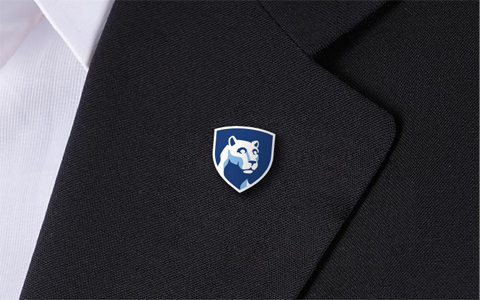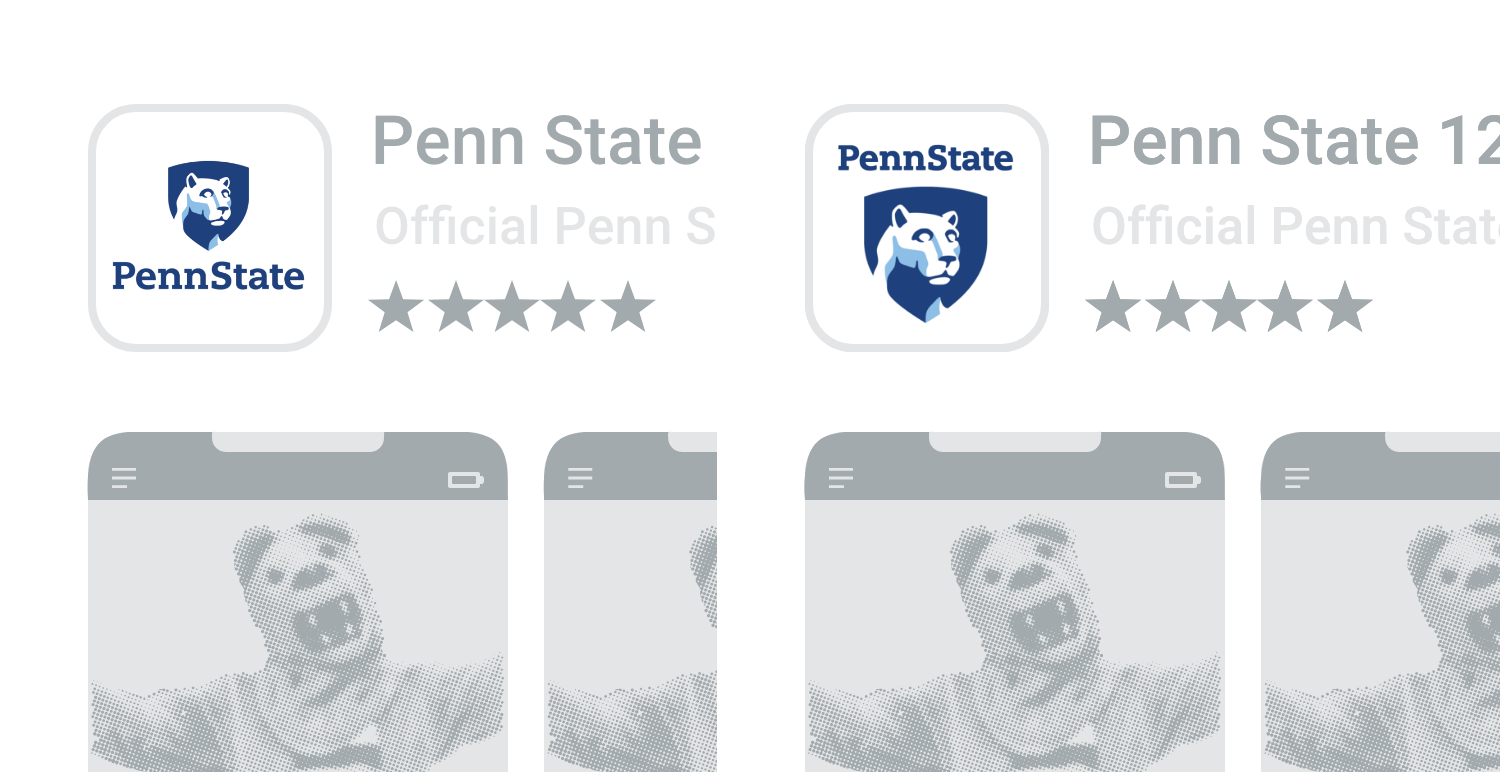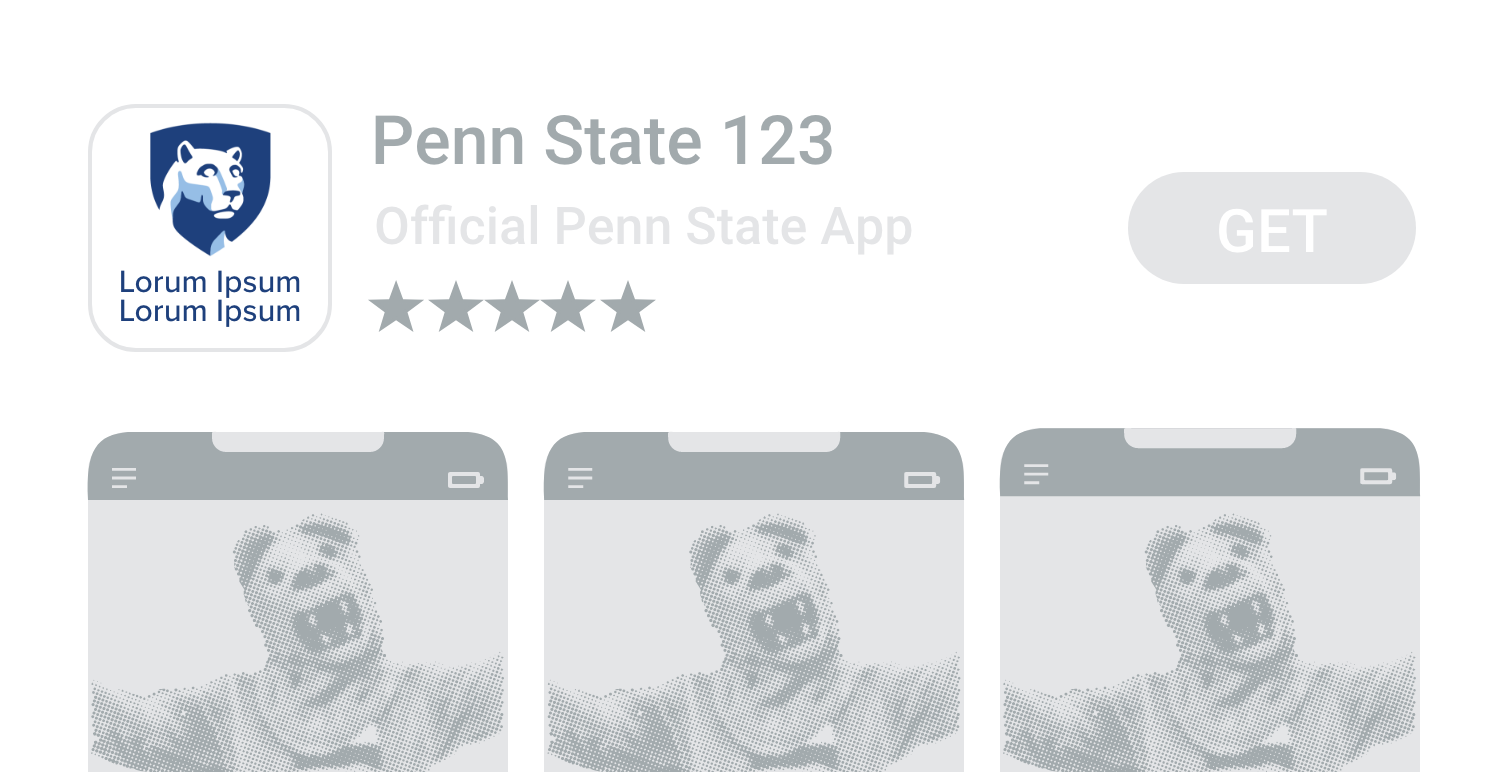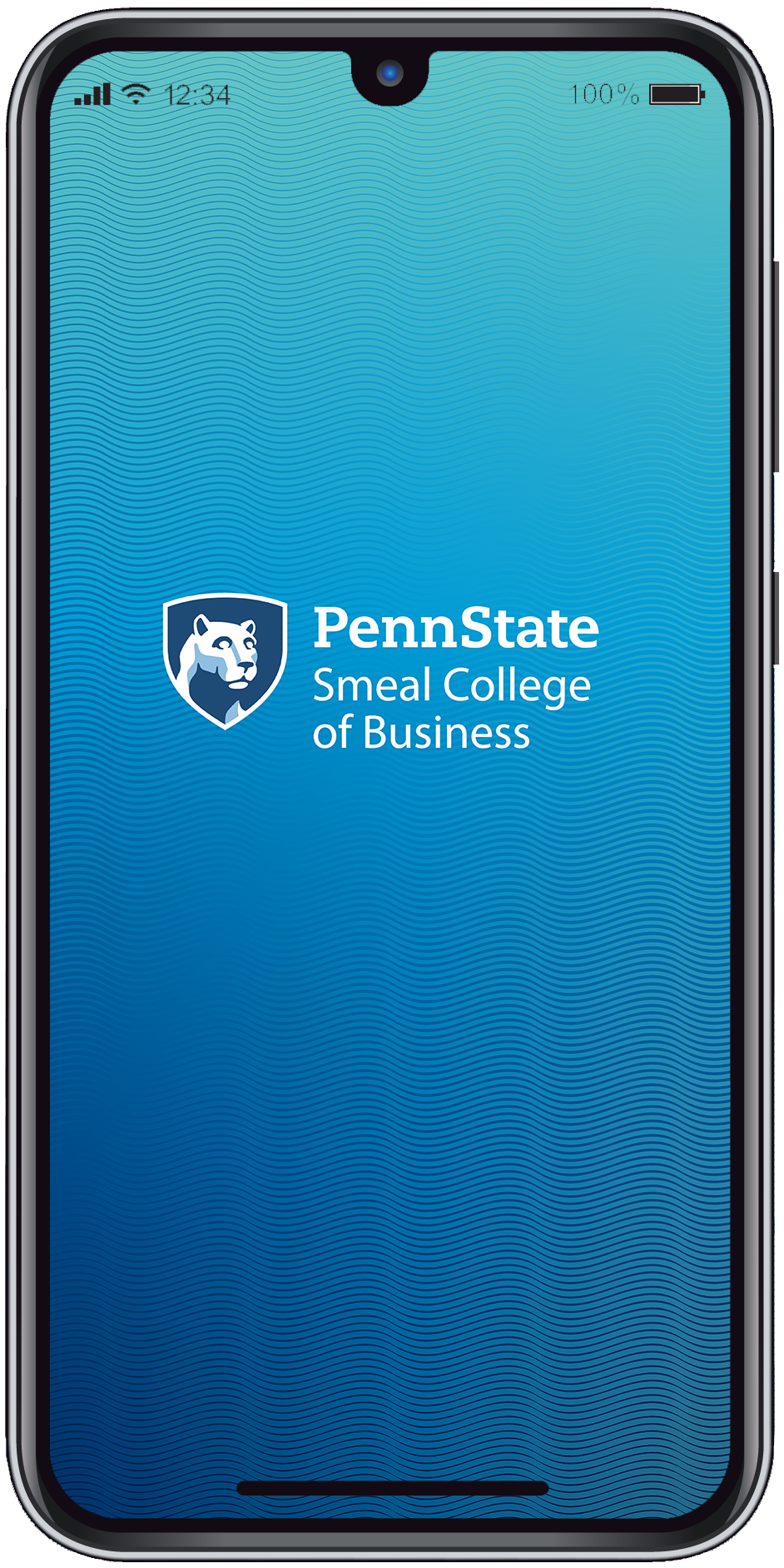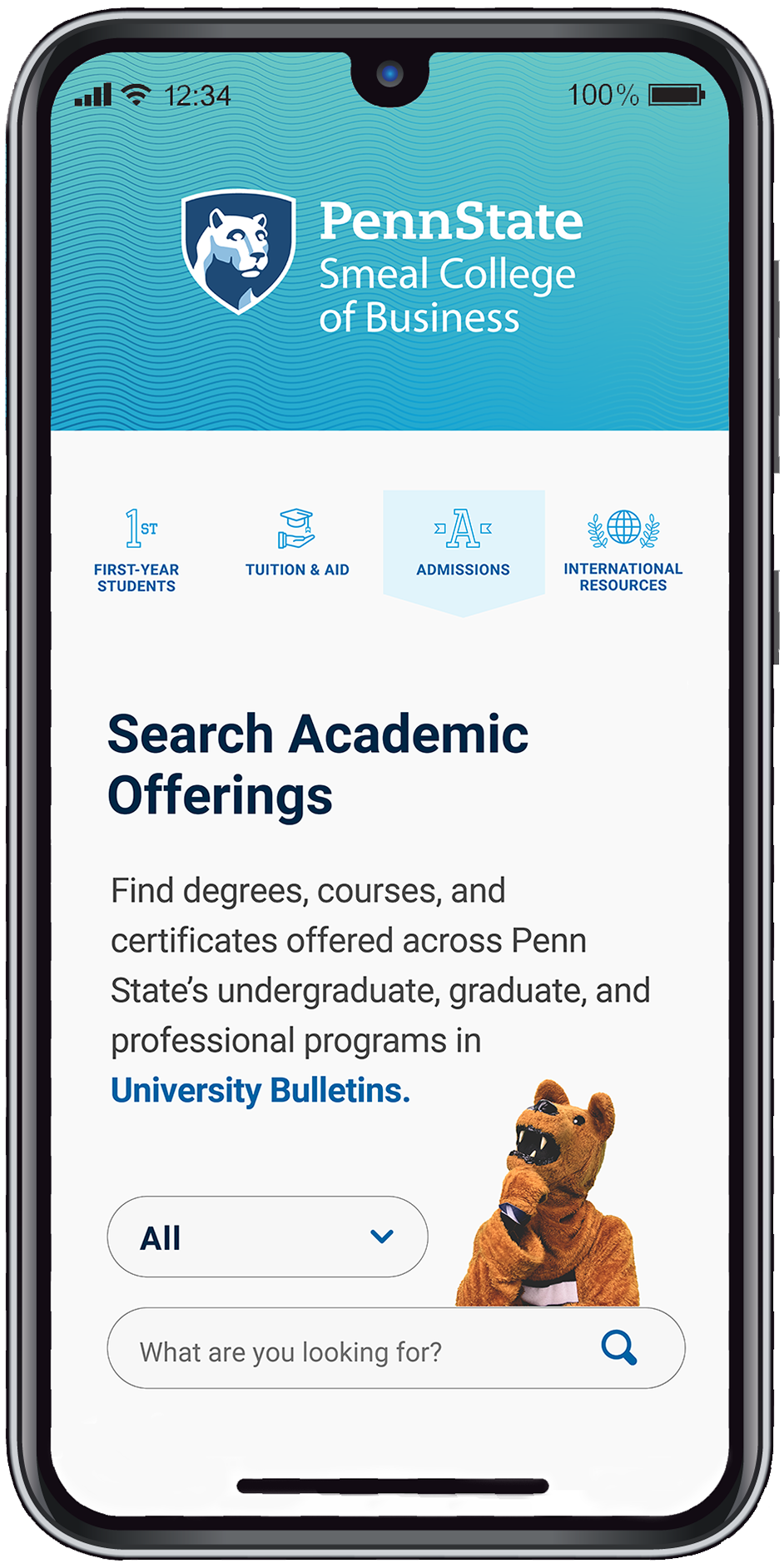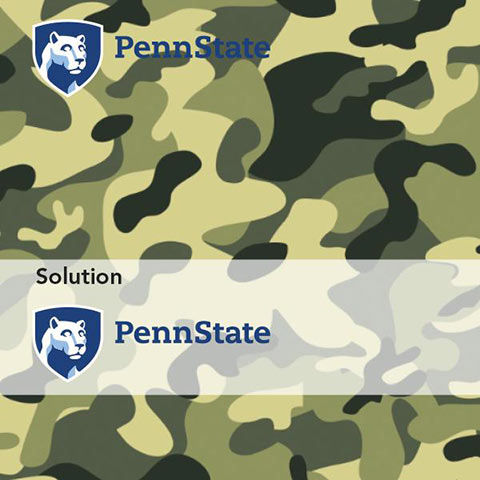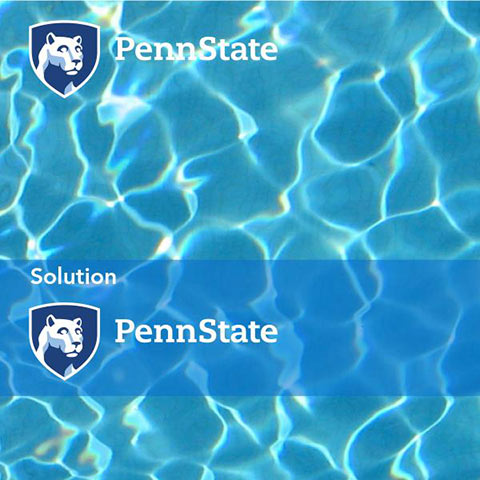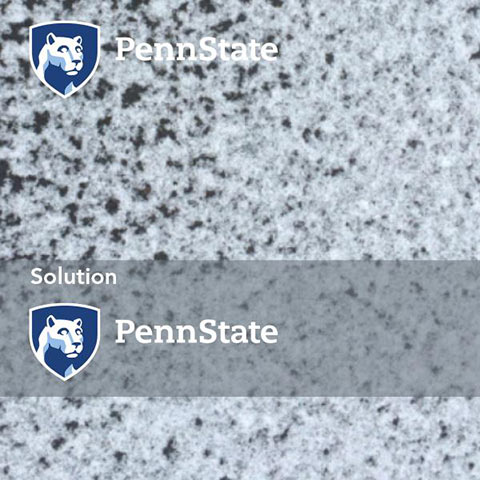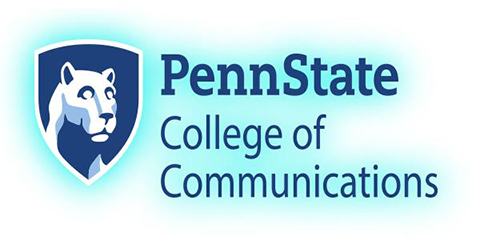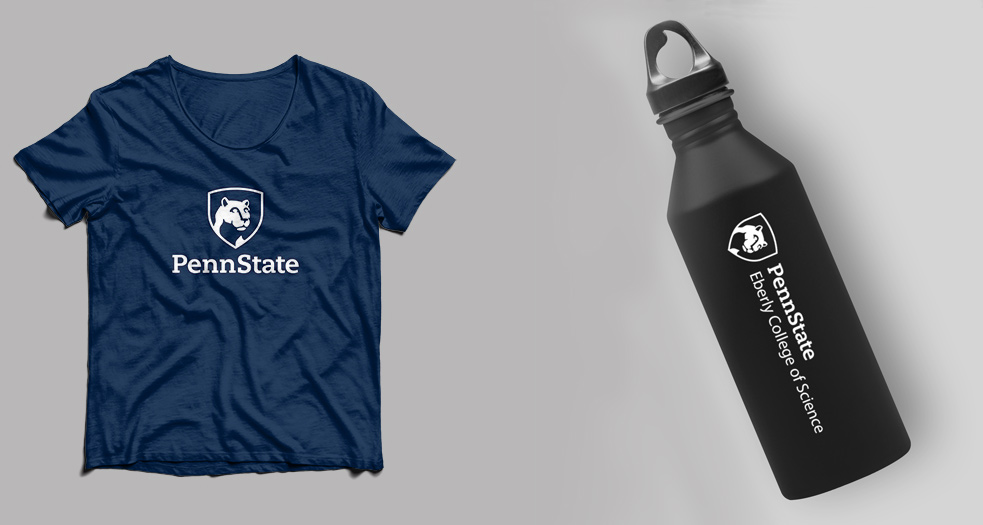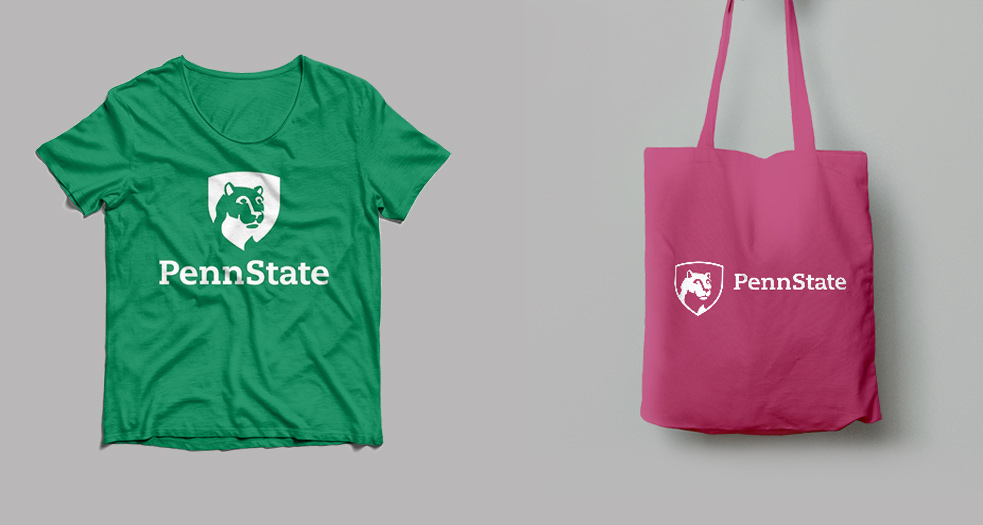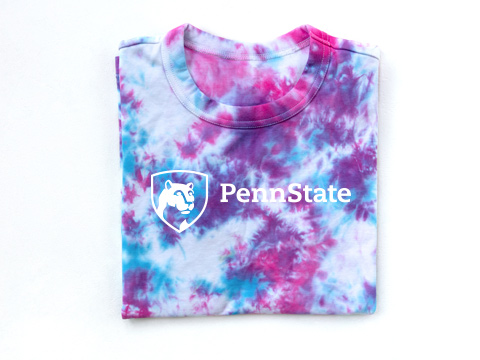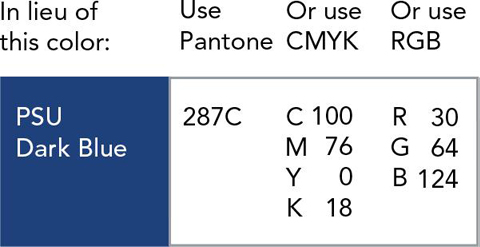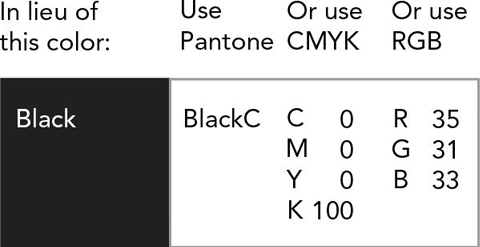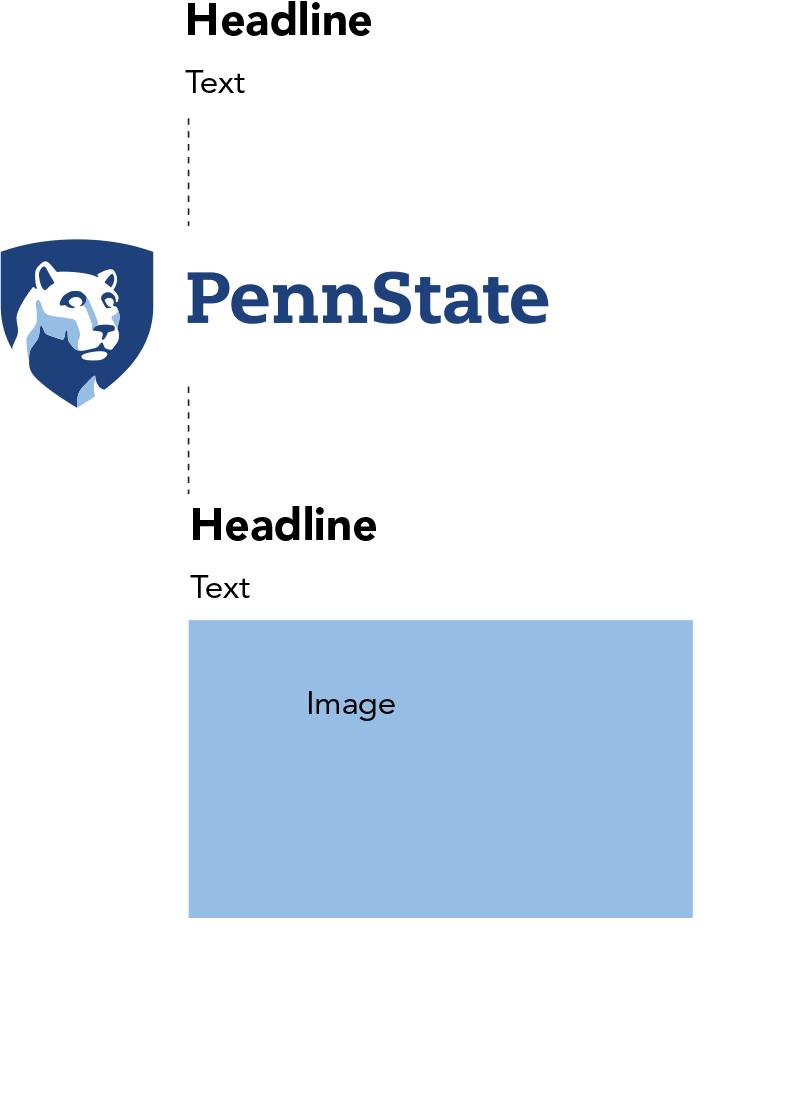Other University Symbols
Various official symbols exist at Penn State in addition to the University mark. These symbols have specific uses and functions and are not interchangeable with the University mark.
University Seal
The seal has been in existence in one form or another since the founding of the University. The current version was introduced in 1953 and features the crest of the Commonwealth of Pennsylvania surrounded by the name of the University. It bears a striking resemblance to the seals of many other state agencies, including the State System of Higher Education, which is the one reason it does not serve as the University’s logo. Since implementation of the University mark in 1987, the seal has served primarily as an official stamp of validation–like a notary’s stamp–on official documents such a contracts and diplomas.
Some versions of the University seal feature a fluted edge. However, the current version with a clean, smooth edge is preferred. The same artwork is used for both positive and reverse reproductions.

NOTE: The University seal is a registered symbol of the Pennsylvania State University and its uses are strictly controlled by the University. Information about the University seal also is available on the Licensing website. Questions regarding use of the seal may be directed to the Office of Strategic Communications at pennstatebrand@psu.edu.
The Nittany Lion
Nittany Lion Mascot Caricatures
Nittany Lion Mascot (“Mascot”) caricatures are available for use by Penn State faculty, staff, and students to represent Penn State pride and spirit. The Nittany Lion Mascot artwork conveys the same traits that our live mascot is famous for such as friendliness, energy, and stellar sportsmanship. Likewise, the Nittany Lion Mascot caricatures must represent Penn State in a positive manner in all use instances. The Mascot caricatures may only be used as decorative artwork in connection with University communications. Penn State faculty and staff may use the artwork in accordance with the University’s Code of Responsible Conduct. Recognized Student Organizations may also use the artwork for their organization’s communications in accordance with the University’s student Code of Conduct.
Any use of the Nittany Lion Caricature artwork must adhere to the following standards:
Personal or Non-University use is not permitted. Do not share artwork with non-University parties unless authorized by the Office of Strategic Communications in writing.
A Mascot caricature may not be used as a logo for a specific area, initiative or recognized student organization.
Mascot caricatures should not be graphically altered. Text or graphics may be placed near the Lion but not touch it. Do not change the Mascot’s color or general appearance as shown. The following exceptions are permitted:
- For the Nittany Lion Sign pose, sign content may include event information, announcements or positive cheer messages such as “We Are Penn State”. Student content must not violate the University’s student Code of Conduct.
- Specific per-caricature cropping guidelines are available in the downloadable pdf.
The Nittany Lion Mascot caricatures are not available for use on merchandise items at this time.
Questions about the use of the Nittany Lion Caricatures may be directed to the Office of Strategic Communications at pennstatebrand@psu.edu. Nittany Lion Caricature files are available for download.
NOTE: In accordance with Penn State Policy AD07, Use of University Name, Trademarks, Symbols, Logos and/or Graphic Devices, the Nittany Lion is considered University Indicia; therefore, the use of this artwork is a direct reflection of the University. Policy AD07 seeks to protect the University’s name and reputation by regulating the use of the University indicia to prevent uses that are not supportive of the University’s mission or values and protect the University from the liability of misrepresentation.

Nittany Lion Mascot with Backpack; Nittany Lion Mascot Number One.

Nittany Lion Mascot with Cake; Nittany Lion Mascot Graduate.

Nittany Lion Mascot with Lab Coat; Nittany Mascot Looking at Sign.

Nittany Lion Mascot with Sign; Nittany Lion Mascot Reading.
Nittany Lion Shrine Illustrations
Line drawings of both the full-bodied view of the statue and three-quarter view of the statue’s head have been standardized as "classic" Nittany Lion artwork. Nittany Lion Shrine illustrations are available for download.

NOTE: Classic Nittany Lion artwork is trademarked by The Pennsylvania State University and its uses are strictly controlled by the University. Information about classic Nittany Lion artwork also is available on the Licensing website. Questions regarding the use of this artwork may be directed to the Office of Strategic Communications at pennstatebrand@psu.edu.
Faceted Lion Shrine
The stylized, abstract interpretation of the Nittany Lion Shrine is reminiscent of multi-faceted gemstones and is inspired by the diversity of our University. The three design iterations (head, full body, and torso) in four different styles are available for download. These designs may be paired with other brand design elements, however one should always be mindful of how our brand elements interact; it’s important to achieve clarity and maintain the integrity (original design intent) of all brand elements. For example, because of the intricate nature of the Faceted Lion design, ensure that graphics and backgrounds do not visually compete in your overall design layout.
Only the simple Faceted Lion Shrine (without the ’S’ curve texture included) may be considered for use on merchandise.
Do not use the Faceted Lion Shrine for embroidery applications.
Do not use the Faceted Lion Shrine in a physical production process with application at smaller than 3” in diameter (the minimum size for the torso and head designs should be sized based on this 3” minimum diameter of the full body design).
Do not change the color or general appearance as provided.

Simple Faceted Lion in black: Full Body, Torso, Head (CMYK, RGB). Also available in white Nittany Navy, and Beaver Blue.

Simple Faceted Lion with ‘S’ Curve in black: Full Body, Torso, Head (CMYK, RGB). Also available in white Nittany Navy, and Beaver Blue.
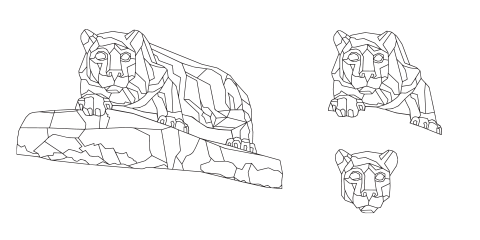
Complex Faceted Lion in black: Full Body, Torso, Head (CMYK, RGB). Also available in white Nittany Navy, and Beaver Blue.

Complex Faceted Lion with ‘S’ Curve in black: Full Body, Torso, Head (CMYK, RGB). Also available in white Nittany Navy, and Beaver Blue.
Nittany Lion Paw Print
The Nittany Lion paw print graphic is available for use by Penn State faculty, staff, and students to represent pride and spirit. The paw print files are available for download. The paw print is trademarked by the University and must not be graphically altered. Other requirements are:
- Text or graphics may be placed near the paw print but should not touch it.
- Use a paw print as accent artwork for Penn State materials but not as a logo for a specific area or initiative.
- Text or graphics should not be placed within the paw print or in the space between the toes and palm.
- Blue is recommended for brand consistency. Black, as well as other colors, requires approval.
- Merchandise featuring the paw print must be produced by licensed vendors (visit the Licensing website for more information), and requires a registration symbol in the location shown below.

Paw Print shown in blue and in black

Paw Print with white outline for use on dark background; Registered trademark symbol location

Do not use the paw print with the name of a campus, college, academic unit, or use as a replacement for the academic mark’s shield; Do not reverse the paw print in white
NOTE: Exceptions to the above information must receive advance approval from the Office of Strategic Communications. Contact Strategic Communications at pennstatebrand@psu.edu for approval or more information.
Penn State Athletics Mark
Penn State Intercollegiate Athletics uses a specific graphic for branding athletic activities and communications. This symbol is often referred to as the Penn State Primary Athletic mark.
- This mark may be used to represent Penn State Intercollegiate athletic activities. It should not be used to represent the University’s academic areas or non-athletic communications and may not be used as a replacement for the Penn State University (or academic) mark.
- Use of the Athletic logo by anyone other than Penn State Athletics staff requires approval by the Office of Licensing Programs. Email licensing@psu.edu.
- The Primary Athletic mark’s official color is dark blue (PMS 282) when used on a white background. It appears as dark blue (PMS 282) and white when used on any other background color. Use of other colors will require approval by the Office of Licensing Programs.
- The lion head always faces right. Do not reverse the orientation.
- Do not alter the mark nor visually attach unapproved text or graphics near or around its perimeter.
- Merchandise must be produced by official licensed vendors (visit the Licensing website for more information), and requires trademark designation. Note the location of the registration symbol.

Primary Athletic mark

Primary Athletic reverse mark on a dark background.

Do not place the Primary Athletic mark on distracting backgrounds.
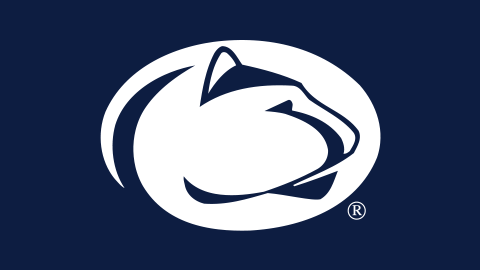
Above is an incorrect reverse of the positive art. It’s easily identified by the white cheek. Instead, use the correct reverse mark as shown above.
NOTE: Exceptions to the above information must receive advance approval from the Office of Strategic Communications. Email pennstatebrand@psu.edu for artwork or more information.
University Marks and Symbols on Merchandise
Penn State names, marks, and symbols are featured on thousands of pieces of merchandise items found in the marketplace. Any merchandise featuring a registered or trademarked Penn State name, mark, or symbol, regardless of who produces it or for what purpose, must follow appropriate visual standards and licensing agreements. Additionally, any University names, marks, or symbols appearing on merchandise should include either the registration symbol [®] or trademark symbol [™] depending on what is appropriate.
Any University unit that would like to produce an item of merchandise should start by visiting the Licensing Programs website or calling 814-865-0356 to locate a licensed vendor or ask questions. University faculty and staff may use Penn State names, marks, and symbols, according to established visual and editorial guidelines, on any materials to be used for recruitment, development, or general promotion of the institution. However, when merchandise or specialty products such as shirts, ball caps, mugs, pens, etc. are produced, those items are subject to a promotional agreement from the Office of Licensing Programs. This is the case whether the item is to be given away for free or sold for profit. In all cases, merchandise and specialty items must be produced by licensed Penn State vendors.
Lapel Pins
Lapel pins are a popular merchandise item used to show Penn State spirit on clothing. The shield represents the Penn State community and is the preferred lapel pin artwork. However, when Penn State unit identification is necessary, an alternate lapel pin template is available. This template maintains the graphic integrity of our shield, while allowing space to add a unit title.
- Unit titles (college, campus, or administrative areas) may be placed in the lower half of the outer rim.
- Do not alter the design or reduce the type size. The space for type is limited.
- The recommended lapel pin size is a 1-inch diameter.
- Lapel pins must be produced by a licensed vendor. Visit the Licensing website for a list of licensed vendors.
- This lapel pin template is designed for internal Penn State use. It is not for commercial use.
- Penn State-related initiatives may be used instead of unit names.

Lapel pin, shield only

Lapel pin template for unit identity. Do not use the lapel pin design template for unit identification in University communications or other items. It is not a replacement for an academic mark. Do not use in any manner that attempts to replicate the University seal.
NOTE: Artwork is available from the Office of Strategic Communications. Exceptions to the above information must receive advance approval from the Office of Strategic Communications. Email pennstatebrand@psu.edu for artwork or more information.
Anniversary Tags
An anniversary tag may used as a graphic accent on most University marketing communications to celebrate the milestone.
- An anniversary tag may be used for a college, campus, school, center, institute, museum or university business.
- The tag should appear in a location secondary to the academic mark, such as the bottom of a flyer or the footer of a webpage.
- Use the tag on print or web marketing communications. However, it may not be added to University stationery produced at the Multimedia and Print Center. The tag may not be used to create new stationery that would not conform to the University’s standardized stationery formats.
- An anniversary tag should be a simple graphic with minimal copy. Tags typically contain the anniversary year or applicable dates and possibly minimal art or text.
- Duration for use is limited. Remove the tag from circulation at the end of the anniversary year.
- A tag must not replace or visually complete with the academic mark.
- Do not use a shield shape or lion artwork. Do not attempt to replicate the University seal.
- A tag is not a logo.
- Avoid using the University’s name or the title of the area being recognized.

Example of a campus anniversary tag

Example of a school anniversary tag
NOTE: Anniversary tag artwork requires advance approval by the Office of Strategic Communications. Send questions or artwork to pennstatebrand@psu.edu.
University-Recognized Student Organization Mark
Penn State Recognized Student Organizations may use a special version of the University's mark on their materials and communications. The University-Recognized Student Organization Shield Mark is made available through Office of Student Affairs, and graphic files may be requested at Student Activities Offices at campus locations. University Park organizations should email studentorg@psu.edu to request the graphic files.
The mark design is unique to Recognized Student Organizations and features the only University trademarked symbol that may be used to graphically identify a Recognized Student Organization. When using this mark, it may not be altered in any way. Organizations must adhere to the University’s color and correct mark use standards.
In addition to communications, any merchandise that features a University-Recognized Student Organization Mark must be produced by a University licensed vendor. A vendor list is available on the Licensing website.












